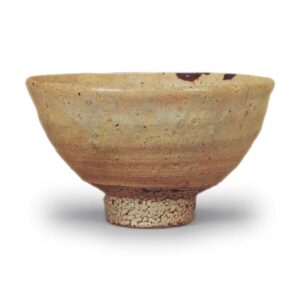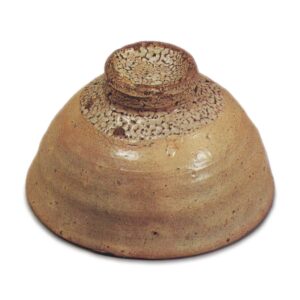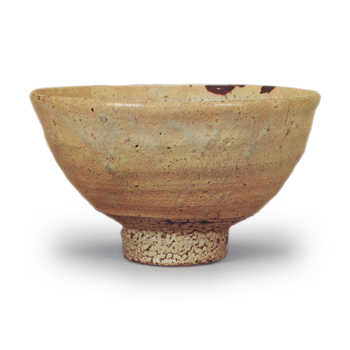

Daimyo-mono
Height: 9.1-9.8mm
Diameter: 15.5-15.7mm
Outer diameter of foot: 5.7mm
Height of foot: 1.8mm
It is named after the legend that Hosokawa Sansai owned it. It is probably the largest of all the Oido bowls, and as the “Unshu-kou-gochibori-hikae” (a book about Oido bowls) says, “It is a little wider than Kizaemon’s bowls”, its bowl shape is so full that it lacks the tightness seen in Tsutsui-Tsutsui and Kizaemon, and for that reason it lacks strength. The glaze is also thin, and therefore the craquelure is finer than that of the Tsutsui-tsutsui and Kizaemon, but the bright beauty of the slightly reddish, whitish loquat-colored glaze is outstanding, and the kaeragi glaze is also magnificent from the scrape marks around the foot to the foot ring. As you would expect, the three bowls, including Hosokawa, are representative of the three types and three states of Oido, and are famous bowls.
In the “Famous Tea Bowl Collection”, it is recorded as “Hosokawa Ido, Oshu-kou”, and in the memorandum of the Edo-based tool dealer Fushimiya, who passed it on to Fumai, it is recorded as “In the possession of Sansai, then in the possession of Kiheiji Fuyuki, and in the An’ei era, it was passed on to us by the Fushimiya family”. , it is thought that it was passed down from the Date family of Sendai to the Fuyuki family of Fukagawa in Edo, and then to Fumai, but it was not until after that that the value of this tea bowl really increased, when it was called one of the three best bowls in the world along with the Honmas and the Kagas. It is said that it entered the Fumai collection in 1778, so it was relatively early in his collection. The “Osaki-sama Goudou-dai Otome-gochi” states that it was purchased from Fushimiya Jinne for 300 ryou. In addition, in the “Matsudaira Fumai Den”, when he handed over the family headship in 1811,
Daimyo-mono-no-bu
- Kitano Kuro, 1. Honda Ido, 1. Hosokawa Ido, 1. Taihagai, 1. Yuteki, 1. Kaga Ido, 1. Kofuki, 1. Waritakadai
The above are famous items in the world. Please take good care of them.
September, 8th year of Bunka, Kanmi
Fumai
According to this, it is clear that Fumai ranked the Mitsui wells as being of the same rank as the Honda, Hosokawa and Kaga wells, and even today, this ranking is probably still appropriate.
The Kaga well became Fumai’s private collection in the Kyowa era, so it was about 20 years after the Hosokawa well was acquired, but the Honda well was probably acquired around the same time as the Hosokawa well, in the An’ei era. If that is the case, what was it about this Hosokawa tea bowl that Fumai found so sympathetic? Perhaps it was the relaxed bowl shape and the elegant glaze, which was tinged with a hint of red and was unlike any other tea bowl, that gave it a taste of the gentle spring breeze. At a tea ceremony held at the Dokkakuan tea house in 1813, Fumai used this tea bowl in early spring, after the middle of February, and it is thought that he did so “with full consideration of the style of the tea bowl”.
The attached bag is a Cantonese-style cloth with white flying characters on a red background, and the lining is a sea-themed pattern with a cobblestone design. The inner box is black lacquered and wrapped in a brocade bag with a round dragon design.



